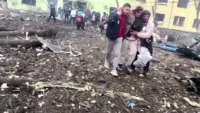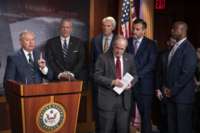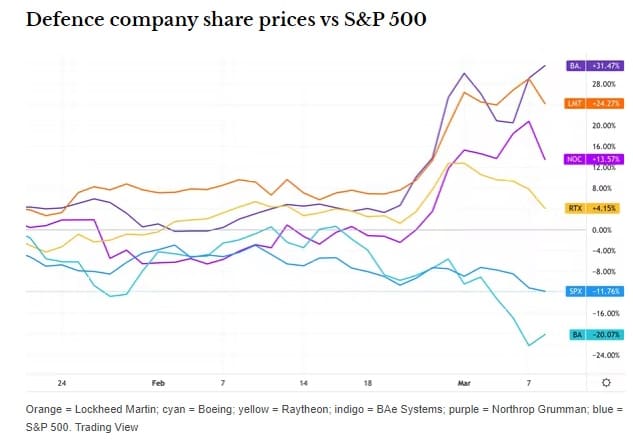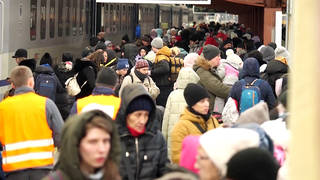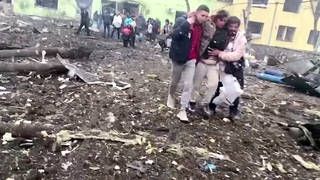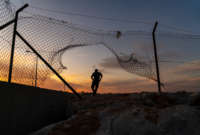
“I think we can reframe and re-understand the immigrant rights movement, not just as one of many movements, but something that is fundamentally connected to how we remake the world,” says Harsha Walia. In this episode of “Movement Memos,” Kelly Hayes and Border & Rule author Harsha Walia talk about the plight of Black students fleeing Ukraine, borders, the climate crisis and taking action in these times.
Music credit: Son Monarcas and Pulsed
TRANSCRIPT
Note: This a rush transcript and has been lightly edited for clarity. Copy may not be in its final form.
Kelly Hayes: Welcome to “Movement Memos,” a Truthout podcast about things you should know if you want to change the world. I’m your host, writer and organizer Kelly Hayes. We talk a lot on this show about movement building and what solidarity demands of us. Today, we are talking about borders and who gets left behind in times of disaster, and we will be hearing from Harsha Walia, author of Border and Rule: Global Migration, Capitalism, and the Rise of Racist Nationalism. Right now, many of us are thinking about borders in the context of war — and more specifically, the war Russia is waging against Ukraine. More than 2 million people have fled Ukraine since Russia invaded. We have heard many harrowing stories of people attempting to escape a nation under siege — and those stories have sadly included the struggles of Black people who were beaten, forced off buses or trains, and turned away as they attempted to cross the border to flee Ukraine. There are also reports of Black students being terrorized by Nazi elements within Poland after crossing the border, including reports of students being killed. As Shamira Ibrahim wrote in her recent piece Africans In Ukraine: Stories Of War, Anti-Blackness & White Supremacy, “No matter how many iterations of ‘racial reckonings’ we contend with, Blackness is continuously assessed on a subhuman level, denied the basic dignities afforded to the ruling class.” In that piece Ibrahim elaborates on the experiences of Black students who have been attempting to flee Ukraine and the online efforts that have sprung up to assist them. I hope everyone will read it and do what they can to help.
In this episode, Harsha and I are going to zoom out, and talk about the broader anti-Black context Ibrahim was referring to, because the experiences of Black people fleeing Russia’s attacks on Ukraine are consistent with larger patterns of anti-Black border violence in Europe. What’s anomalous about this crisis, from an immigration standpoint, is that EU nations actually seem poised to absorb millions of refugees as the war continues. In late January, Poland began constructing a 115-mile wall, equipped with motion detectors and thermal cameras, with the goal of preventing asylum seekers from entering the country. Since Putin announced that Russia would invade Ukraine, almost 800,000 refugees have crossed into Poland from Ukraine.
This is not a problem specific to Ukraine or Poland. The BBC, which is a public service broadcaster in the UK, recently aired an interview with a former deputy prosecutor general of Ukraine, who stated, “It’s very emotional for me because I see European people with blue eyes and blond hair … being killed every day.” The BBC host conducting the interview replied, “I understand and respect the emotion.” Similar sentiments echoed across news commentary in Spain and France. The issue we are facing here is not one specific to the situation in Ukraine, but rather, how western racism dictates who is deemed worthy of survival, and who should be left to endure the unsurvivable.
We have seen similar shows of racism from U.S. media outlets, and a similar willingness on the part of U.S. leaders to welcome Ukrainian refugees. The Biden administration’s treatment of Haitian refugees who had just endured a major earthquake, political chaos, and rampant street violence, in the wake of a presidential assassination, is now infamous — as we previously discussed on this show. Thousands of migrants have died along the U.S. southern border, trying to cross into the United States, since 2001, when tightened border security in Texas and California started funneling migrants into the desert. Migrants are forced into that deadly path regardless of what horrors they are fleeing, and the fact that many of them will die is not a bug, but a feature. As Harsha wrote in Border & Rule, “The doctrine of deterrence requires mass border deaths to instill fear and prevent migration.”
We live in an era when millions of people are fleeing climate catastrophes, identity-based persecution and unrelenting violence. In the assistance that is being readily extended to white Ukrainians, we see that there are circumstances under which western nations are willing to reconfigure what’s possible, in order to accommodate the survival of those in need. But such systemic reimaginings do not extend to Black or brown people. I asked Harsha Walia for her thoughts on how the experiences of Black students and migrants fleeing Ukraine reflect the larger realities of what she calls “Fortress Europe” — an “intricate web of imperial control” that is built on the “genealogies of empire, settler colonialism, transatlantic slavery, and indentured labor.”
Harsha Walia: I think what the past week has really brought into kind of stark light is very much the realities of Fortress Europe, and really just the fundamentally exclusionary anti-Black nature of borders around the world. And in thinking about what’s happening for refugees at the Ukrainian and Polish border, but also multiplying on other borders as well, Hungary and elsewhere, is I think one thing that becomes very obvious if it wasn’t already is how porous the border actually is, which is that the border is not actually intended to exclude all people. The border has always been a project that is intimately and intricately tied to colonization and through which race is reproduced. So we see in this moment the idea of there being two lines at the border where people who are believed to be Ukrainian read through race, because of course there are Ukrainians who are not internationals, who are Afro Ukrainian, for example, or even those who are Roma, who are racialized in very particular ways in Europe are literally put into different lines regardless and irrespective of their citizenship, who are read so clearly through these global hierarchies of race.
So that is one thing that if it wasn’t already obvious about the function of the border, and really its porousness and its flexibility as a regime, that should be very stark to people now. The other thing is that I think it really highlights is how Fortress Europe has really expanded its borders in recent years. I don’t know how much people know about the relationship between Ukraine and the EU in the context of immigration. Of course there’s a lot of talk right now about Ukraine’s attempts to join the EU, as they have for many years in the context right now of the illegal and horrific invasion by Russia. But also one of the things that Ukraine has been pushing, as have other countries like Moldova and Croatia, is that in order to secure their membership into the EU, they have been forced to join the Eastern Partnership and EU border assistance missions as kind of a condition of even being considered for welcoming to the EU.
So what has been happening at the EU for the past week is also not an anomaly, because for especially the past year, it has been a border crisis. Last year in particular, refugees from Afghanistan, and Syria, and Iraq and Yemen were stranded at the border of Belarus and Poland last year, and Polish border guards had barbed wire fencing that blocked them from entering the EU. Many people died. And even the week that, just earlier in the week, when what was happening at the Ukrainian Polish border started to come to light. Earlier that week, a man from Yemen actually died at that very same border. So I think the other thing that’s important to know is how this is situated within the border practices and policies of the EU, which is the world’s deadliest border.
The European border is the world’s deadliest border. And it’s not a singular border, it’s constantly expanding. So that’s also a necessary piece of this, because Europe is nothing, if not a mass history of colonization and plunder of enslavement. That is the origin of a lot of the contemporary continuities of violence. Even for the Europe to establish itself as so-called Europe very much is an anti-Black and anti-Muslim myth that dates back centuries, and that has been really the birthplace of immense violence. And so I think we have to hold all of those continuities together in this current moment, alongside many other continuities as well, of course, but in the context of the border crisis, if you will.
KH: As the climate crisis intensifies, half of all plant and animal species on Earth are migrating. We, as humans, are part of that mass scramble, but in our case, nation states are placing heavy constraints on the movements of many people who are attempting to survive. The global south has been looted, pillaged and exploited by the U.S. and other imperial powers since what historian Gerald Horne calls the dawning of the apocalypse in the 16th century. Now, as the climate crisis and other consequences of capitalism and colonialism make more and more land unlivable, many people are in desperate need of a path to survival. But in 2022, the same forces that initiated the era of catastrophe we are experiencing are dictating whose lives have value and whose do not. White supremacy, capitalism and settler colonialism brought apocalyptic events to Africa, Asia and the Americas hundreds of years ago. Now, the capitalist cycle of conquest, extraction, annihilation and exploitation has reached a stage of mass destruction that is much more visible, imminent and widely experienced than the previously compartmentalized creation of death worlds and sacrifice zones.
HW: I feel like the climate catastrophe is an outgrowth of colonization and capitalism, a symptom of it really. It’s not a standalone issue that can be analyzed outside of the context of the political economy that we live in is really going to bring the issue of migration and borders to the fore even more than it already is. Right now, estimates show that climate disasters displace about 25.3 million people annually. And I know when we start getting into big numbers, it can be hard to understand the scope and scale. So to put that in context, that’s one person about every one to two second. And just in the past five years, approximately since 2016, 2017, the last five years, new displacements caused by climate disasters have outnumbered new displacements as a result of political persecution, which is the kind of very traditional idea of displacement in the kind of World War II, post-World War II context.
So new displacements caused by climate disasters have outnumbered new displacements as a result of persecution by a ratio of three to one. So it really is one of the fastest growing forms of displacement. Of course, hard to separate and tease out different forms of displacement from each other because they’re so constituted through each other. But if we can just to make the point of how severe and serious this is. And it’s not a coincidence that those who are most vulnerable to any form of displacement, including climate displacement, reveals these very same fault lines that we were talking about, the fault lines between rich and poor, between the so-called Global North and South, between whiteness and its Black, Indigenous and racialized others. So we have these asymmetries of power that create migration, including climate migration, but then constrict mobility through the use of borders, displaced people who are the least responsible for global warming now face militarized borders.
And in the last decade in particular, the kind of main rationale that’s being given for militarizing borders is in fact climate change. So this new discourse of climate security that doesn’t deny climate change. So we’ve gone from an era of outright climate denial that is rapidly shifted to climate security. And climate security becomes a way to present climate migration and to have it dovetail, basically into national security discourse. And it’s become the kind of latest excuse for wealthy states around the world to fortify their borders. So in Australia, for example, Australian defense forces announced that military patrols around Australia’s waters would be instituted and implemented to intercept climate refugees. And the U.S. commissioned a report on the security implications of climate change, the Pentagon did. And if I can quote from it, it’s really telling.
So in this report commissioned by the Pentagon they wrote, “borders will be strengthened around the country to hold back unwanted, starving immigrants from the Caribbean islands, an especially severe problem, Mexico and South America.” And as we know, since then we’ve seen a number of examples of how the U.S. has weaponized climate displacement in order to buttress its border. Operation Vigilant Sentry off the Florida coast. There’s a whole new Homeland Security task force, which is called the [Homeland Security Task Force Southeast], which is to enforce Marine deportations in the aftermath of any disasters in the Caribbean. And in Europe, really far right wingers, like Marine La Pen, have actually said things like, “borders will be the environment’s greatest ally. It is through them we will save the planet.”
And again, it’s not a coincidence that this kind of climate security discourse is of course connected so deeply to ecofascism. The kind of outright right-wing screeds that we see that now claim to care about the environment through these kind of Malthusian theories and Darwinian theories of fortifying the borders, protecting us versus them, climate refugees as the latest quote unquote invasion. So it’s really, it’s deeply concerning. And I think we need to be thinking about climate change through an internationalist lens; it requires us to actively fight against eco fascist tendencies of which borders are a key instrument.
So if we really want to think about not being NIMBYs who are only concerned about fossil fuel production in our backyards, but really about the scope of climate change internationally, it means both being attentive to the ways in which those who are most impacted by climate change are Black, and brown and Indigenous communities in the so-called Global North, and of course Pacific islander, and island communities and communities impacted by drought and famine around the world. And also the ways in which they’re not only denied their lands, and lives and livelihood, but are also then denied the ability to seek any kind of safety. For me, it is just so necessary that for us to be internationalists and for us to think about climate change in an expansive way that will actually get to the source, that we think about how to end both climate displacement, and also how to ensure safe climate migration.
KH: When I hear stories about Black and brown people being turned away at borders in the wake of disaster, I am also reminded of people fleeing in the aftermath of Hurricane Katrina who had bullets fired over their heads by police, when they tried to cross the bridge into Gretna. Residents in the white enclave of Algiers Point formed armed vigilante patrols that hunted displaced Black people and shot down “anyone who didn’t belong.” We see these dynamics at work, both within and outside the United States because race animates political life under capitalism.
HW: I think absolutely Hurricane Katrina really laid bare the workings of specifically anti-Black warfare through mass displacement, and also carceral immobility. Undoubtedly it revealed mass displacement and the idea of whose lives are worthy or not. And so first we had Black homes that were most vulnerable to the storm. We had, as you noted, Black people who were criminalized during the storm and shot at, and all that kind of criminalization we saw for people trying to survive.
And also that Black neighborhoods were completely abandoned by recovery efforts after the storm, as you pointed out. I know that so many studies that have been done even recently show that over 75 percent of the almost 1 million displaced people, that scale was immense, conservative estimates are anywhere from 800,000 people were dislocated to up to a million people, that three quarters of them were Black residents. And then of course, after that we saw not only were they permanently displaced and dislocated, but the mass kind of privatization, and the policing and the austerity measures that were brought into neighborhoods within New Orleans. So we see the interplay between not only displacement, and permanent displacement and immobility, but how that’s then used to actually just further the same kinds of policies that even create certain forms of displacement through privatization, gentrification and more.
And so, I think absolutely this concept of displacement isn’t just about borders. Fred Moten, who was drawing on the work of Cedric Robinson, he talked about the position of Black people in the United States as one of a quote, eternal, internal alien. So we know that citizenship is already hollow and unevenly distributed, irrespective of one’s actual legal status. And displacement is at the core of so much of how capitalism and colonization work. Indigenous peoples being displaced from their lands predates the kind of entrenchment of modern nation states’ borders. And the entire process of empire and colonization was one of mass displacement and dispossession, because that is really the function of both capitalism and colonization, is to remove people from the land, to capture land, to turn it into a commodity, make it into private property, and then to use citizenship as one of many racial weapons.
And so, I think of bordering practices as distinct from the border. The border is just one place where we see this operating, but bordering practices are many. When Angela Davis and Gina Dent wrote that the prison is a border, that resonates because it is bordering regime, of creating the land of really entrenching the idea of who is free and who is unfree. The creation of reserves and reservations are bordering practices. To say that Indigenous people now have to be forced into little parcels of land, and the rest of the land becomes a massive project of colonization and becomes parceled into private property, becomes crown or public land, that is also a bordering practice by forcing people into small parcels of land and saying this is all that you can live on.
There are many practices of bordering that fundamentally rely on mass displacement. So it’s not new, and what we need to pay attention to is those in historical continuities, the ways in which bordering is not just operating at the border, which means that, as you noted, that this becomes not just about the national border. It’s not just, for example, the U.S.-Mexico border. It also becomes a struggle between jurisdictions already within a border. So whether that’s between states, whether that’s between cities, that gets exacerbated. And absolutely with the kinds of resource wars that we’re seeing, this is going to get amplified. I’m in so-called British Columbia where there’s been many ongoing struggles against pipelines, including the Wetʼsuwetʼen struggle against pipelines, the Coastal GasLink pipeline, which is a fracked gas pipeline.
And they have been blocking this pipeline for over 10 years. And as a result of direct action, of kicking the pipeline line out of their territory, and of [having] faced down paramilitary and the police state, there’ve been multiple raids on their territory. And now in light of what’s happening globally, and in light of specifically what’s happened in light of the Russian invasion of Ukraine and this scramble, and the delight that the fossil fuel industry has, because it’s giving them an excuse to ramp up domestic fossil fuel infrastructure. So we’re suddenly seeing the kind of the ramping up of energy security discourse also happening parallel to this horrific invasion. It’s the capitalists who are warmongering, as they always do.
And this is a direct threat now to communities like the Wetʼsuwetʼen, who are facing down already this pipeline infrastructure, and now are going to see this ramped up, war mongering, domestic capitalist kind of vultures who are going to be trying to come into their territory even more. And so this is also the global effects of what’s happening that we need to pay attention to. Because when we say that the war abroad boomerangs back home, it’s not just the ways in which foreign policy, if you will, or the arena of foreign policy starts at home, but also that the war boomerangs back home onto Indigenous, and Black and racialized communities in very particular ways.
KH: Something I am really concerned about right now is that, amid so many events that feel so large, and so far beyond our control, is that people are going to get stuck in this mode of watching and worrying, and forget their own power. Because some of the things we are up against are so enormous that our minds can barely make meaning of them, and I think that leads a lot of people to forget just how much hinges on our complicity — or our willingness to act. So I asked Harsha if she had any advice for our listeners, in terms of how to approach this moment, and what we should be doing with ourselves right now.
HW: For me, a politics of organizing is so necessary, otherwise we get stuck in the kind of demobilizing fatalism of things will never change because it’s too immense. Or of course, the kind of utopic romanticism, which is like, it’s not that bad. It is really, it’s really fucking bad. The world is a deathscape for the majority of the world’s people. I don’t think we all sit with the immensity of that, and of course escalated in the pandemic. Just everything, everything around us is showing us how disposable so many people are across so many different social locations, so many race, class, sexuality, gender, disability, so many, multiplied depending on where you live in the world determines literally how long you will live. The fact that there are places in the world that have half the life expectancy of other places in the world is a literal deathscape. And the fact that the world’s majority still don’t have access to boosters is a literal deathscape in a global pandemic.
We don’t sit with the immensity of it for whatever reason. I can’t analyze that. Some of its complicity, some of it’s our own, we shut down parts of our brain because impending and already existing apocalypse is hard. And that’s the reality also for a lot of people who talk about how you survive war, is you try to quote unquote, have a normal life. Even though we know going back to normal is not an option, but you kind of hold those contradictions. But I think what we do have is knowing that these systems, as powerful as they are, are interconnected. And for me, I actually find some… solace is not the word. But when I think of this big, immense web, knowing that it’s big and interconnected in some ways is less daunting, because no matter what part you’re working on, you can know you’re working on all of it.
If you’re working to fight against gentrification in your neighborhood, if you are running mutual aid networks in your neighborhood, if you were stopping police and or military recruitment in your neighborhood, if you are providing sanctuary to undocumented migrants in your neighborhood, that is all intricately connected. So when we all play a role in unraveling this massive web, it will actually be undone. There’s a saying in Oaxaca, which is that we are many hands in one heart in the struggle. And I think that is very true. There is no way that we are going to break down this immense system by tackling it at one point, because that will inevitably lead to playing whack-a-mole. What we do need is many hands in the struggle, and all trying to do our part and seeing that it’s connected. We may not be able to act on everything, but we do have to be able to see how it’s all connected so that we are strategically contributing to dismantling the same thing, so that we’re not pulling in different directions.
So for me, that’s the kind of analytic freeing that gives me hope, and also the necessity of organizing. There’s no way to describe how the only way to overcome that individual powerlessness is through collective struggle. Because also one of the things that the system does is to make us isolated, and through that isolation, not only do we feel isolated, and alone and atomized, we also feel powerless. And so I don’t actually believe any individual can regain power. I know there’s this nonprofit trend of the individual change maker, and the trender and the influencer, whatever. It’s just not possible. That’s another neoliberal gimmick. What we need is each other. We need each other literally to survive and we need each other in the struggle, because it is only through the actual proximity of seeing each other’s humanity, of struggling together, of being co-strugglers that we actually feel empowered.
“Empower” has become a hokey word because it’s been disassociated from collective struggle. It’s the idea of individual empowerment. No, we need to feel empowered through collective struggle. And so I think those are some of the ways in which we can overcome our complicity and or our sense of immobility or powerlessness is through struggle. And to realize that even though what we are facing is so daunting, if we each play a part, we chip away. We chip away at the bricks. We literally chip away at the bricks of the border. When we do any kind of project in solidarity with any person in struggle, it makes the difference and we see those ripple effects. But I think seeing the immensity of the problem is necessary, but it shouldn’t lead to demobilization, it should lead us to understand that we actually all have a role to play because it is all connected.
So if we see things as siloed, then it can lead us to be like, oh, I got to fight one thing, but then you’re telling me I have to also fight 100 things and I don’t have capacity to fight 100 things. But if we see that actually our fight is one massive struggle to which hundreds of things are tethered, then fighting our one piece of that puzzle can untether the whole thing. And I think, again, that’s the analytic frame that I think helps overcome that sense of how and where do I contribute? This might be my particular vantage point, but I really think that one thing, especially coming back just to the specificity of the border, and what we’re witnessing and what we have been witnessing for years, this is not a new quote unquote crisis, this is a crisis of displacement and immobility that is centuries-old, and especially escalated decades-old.
If we reframe what’s happening at the border as a crisis of displacement and immobility, we start to see that this isn’t just an issue of immigrant rights or migrant justice, that this is fundamentally at the heart of freedom. All freedom has been constrained in some shape or form through forms of social control that are meant to demobilize and immobilize communities in struggle. So if we can understand the crisis of displacement and immobility as what underwrites racial warfare, as what underwrites Black and Indigenous genocide, as what underwrites the exclusion of the border, as what underwrites global apartheid when we think about systems like citizenship, then I think we can reframe and re-understand the immigrant rights movement, not just as one of many movements, but something that is fundamentally connected to how we remake the world. To argue against borders, to say that we need to live in a world that doesn’t have borders is not only to struggle for the rights of displaced people, refugees and migrants.
It is to fight for liberation so that we are all able to live with freedom in our neighborhoods, to fight against gentrification, to fight against settler colonialism, to be able to be at home in our bodies, that these are all much more profound politics of freedom and ungovernability, if you will, to not be dictated by authorities in power and the nation states. To become ungovernable is so central to the politics of no borders. So it’s not just the site of the border, but it is really to fight against all bordering systems, which includes war, which includes empire, which includes the sweat shop, which includes the prison, which includes drone warfare, includes all of it. That that is fundamentally what a no-border struggle is about. When we’re saying no borders, it is a struggle for freedom against all forms of captivity and control.
KH: What Harsha said about reunderstanding the immigrant rights movement “as something that is fundamentally connected to how we remake the world” speaks to what this moment demands of us, and of our imaginations. We are living in catastrophic times and decisions are being made, on a continuous basis, about who deserves a shot at survival, and who should be left to endure the unsurvivable. This is apparent to anyone who is doing prison or jail solidarity work right now, or anyone in the disability justice community, in addition to people doing migrant justice work. It’s also apparent to anyone who is resisting the violence of colonialism and imperialism. The public’s tolerance for mass death is escalating. To confront that ominous trend, we have to challenge the bordering systems that restrict people’s access to survival, and to one another. As Harsha said, to become ungovernable is central. Our solidarity, our willingness to act, our compassion and the mutual aid we extend must grow freely, unbound by legal restrictions and false demarcations. We have to care deeply, rather than giving in to cynicism, and challenge the violence of bordering throughout our lives. And we have to do that work together, because as Harsha said, we cannot regain our power alone. Our power is collective. Splitting us off, into an atomized existence, weakened that collective power, but when we come together, our potential rises, and new possibilities are born.
Circling back to the experience of Black refugees in Ukraine: I want to note that some people have depicted the harms Black refugees have experienced as Russian propaganda. Others have argued that even though the stories are true, they should not be emphasized right now, because doing so helps Putin and hurts Ukraine. We have to reject that kind of erasure. We cannot abandon people, or the truth, in the service of better propagandizing a war. What we need is a bigger conversation — one that neither falsely homogenizes Ukraine nor exceptionalizes the racism and cruelty Black people have experienced there during this war. While those harms must be challenged, they must also be addressed on a much broader scale if we are going to take on the forces that are destroying the world, and boxing people out of habitable spaces, border by border, on a racialized basis.
As Harsha said, we can all resist the norms and dictates of bordering and disposability wherever we are, and I hope we all feel called to do that, in whatever ways we can. I want to thank Harsha Walia for sharing her wisdom with us today. I love talking to Harsha and I am profoundly grateful for her work. If you do not own Border & Rule, please get yourself a copy. It is an essential resource that I return to regularly, and we should all be equipped with that wealth of knowledge. I also want to thank our listeners for joining us today, and remember, our best defense against cynicism is to do good, and to remember that the good we do matters. Until next time, I’ll see you in the streets.
Show Notes
This post was originally published on Latest – Truthout.


